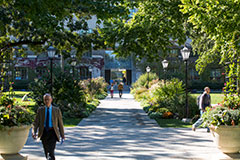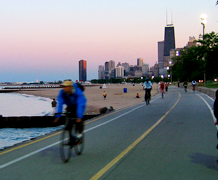Chicago Attractions
Our City
Chicago is our laboratory, our playground, and our muse. We encourage you to spend some time exploring the City that Works. Spend some time on the Chicago Tourism website.
Jump to:
Tours
There are many ways to explore the City of Chicago. You may want to ride a boat or a segway; focus on the food, beer, or architecture; see the famous points of interest or learn about Chicago life.
Chicago Architecture Foundation Tours (Boat, Walking, Bus, etc)
The Chicago Architecture Foundation offers a variety of ways to explore the history and architecture of downtown Chicago and some surrounding neighborhoods. CAF’s popular boat tour provides information about more than 50 buildings along the river, while the walking and bus tours are themed to describe certain groups of architecture. Bike and Segway tours are also offered. Tickets range from $15 for some walking tours, to $44 for boat tours.
Chicago Neighborhood Tours
Explore a few of Chicago’s 77 diverse neighborhoods with Explore Chicago’s neighborhood tours. Tours are on Thursday, Fridays, and Saturdays at 10:00 am, and focus on a different area each time. You might want to learn more about the pubs, historic parks, art in the public transportation systems, or the foods of a certain culture in the area. Tour tickets range from $30- $55. You can also venture to these neighborhoods on a self-led tour: see the Neighborhoods section below for more information.
Chicago Food Tours
If the plethora of Chicago’s downtown and neighborhood restaurants delights your taste buds, you may want to go on a tour focusing on food. Chicago Food Planet offers a number of filling 3-hour culture and food-tasting walking tours. Prices range from $45-$60. Bike Chicago offers Bike & Food tours, which allow you to explore the foods that made Chicago famous, or taste the city’s sweets. Prices range from $50-$60, including bike rental.
Segway and Bike Tours
Chicago Detours
Chicago Detours, founded by a UChicago Alum, shares stories and places even locals don’t know through guided tours of Chicago architecture, history and culture. Walking tours of interior architecture, historic bars, food history and Chicago neighborhoods are available seven days a week, all year.
Chicago Cultural Center Tour (Free)
Visit the Chicago Cultural Center to see the world’s largest Tiffany stained-glass dome and ornate mosaics and learn more about Chicago from the Visitor Center. Free public tours are every Wednesday, Friday, and Saturday, at 1:15 pm, but are limited to the first 20 people.
Free Tours by Foot Chicago
Attractions
There a number of locations that downtown Chicago is known for—certain skyscrapers, museums, theatre (signs), or art installations. Here is a short guide and a pointer to more resources.
Chicago Theatre
Cloud Gate in Millennium Park, AKA The Bean
The Magnificent Mile
Navy Pier
Navy Pier is Chicago’s amusement park. Located between the Loop and the Magnificent Mile, the Pier hosts Cirque du Soliel shows, fireworks, carnival games, and a number of dining and shopping locations.
Willis Tower Skydeck (103rd Fl)
The Second City (Improv Comedy Club)
Art Institute of Chicago
Museum of Contemporary Art
The Museum of Contemporary Art features a number of eclectic collections at a time, changing every three months or so. MCA also hosts occasional dance and song performances as well. Admission is $12 for adults, $7 for students, and free for IL residents on Tuesdays.
Shedd Aquarium
Field Museum (Zoology, Botany, to Geology)
Alder Planetarium
Lincoln Park Zoo (Free)
Cultural Museums
In addition to the comprehensive collection of science and art museums, Chicago is also home to a number of cultural museums. These may focus on the story of the Chicago River, African American history, Mexican history, broadcast communication, and beyond. Visit UofC Chicago Studies or the Chicago tourism website for more.
Neighborhoods
The City of Chicago includes 77 diverse neighborhoods just north and south of the loop. Each features its own style of art, shop collections, cultural cuisines, and rich history. Here are a few, listed from closest to farthest from Hyde Park. The parenthesis shows the cuisine, art, or attraction it tends to be known for.
Chinatown (Chinese)
The community of Chinatown is decorated with traditional red arches and dragons, and a favorite location for all styles of Chinese food, bubble tea, and dim sum. There are a number of pastry shops and supermarkets that offer authentic Chinese products.
Pilsen (Mexican)
Pilsen is the home of the historical Museum of Mexican Art, and is a bustling center for art galleries and authetic Mexican food. The buildings here are vibrantly colored. Irish, German, Polish, and Italian cultures are also found here.
Greektown/Little Italy (Greek/Italian)
Greektown keeps the Greek heritage alive, with the National Hellenic Museum, an annual Taste of Greece, and well-established Greek restaurants. The area known as Little Italy features a number of Catholic churches, the Hull House Museum, the University of Illinois at Chicago, and the expected Italian restaurants.
Old Town (Fancy old Chicago)
Old Town is where the busy heart of Chicago used to be, with ornate upscale townhomes, picturesque landscaping, and a number of boutiques. Second City, along with the Steppenwolf Theatre, find their homes here.
Lincoln Park (Zoo and beaches)
Lincoln Park is right by the lakeshore, with good beaches and tree-lined streets for jogging. There are a number of boutique stores and restaurants here, as well as a number of attractions. The Lincoln Park Zoo, Chicago History Museum, Peggy Notebaert Nature Museum, Lincoln Park Conservatory, and the Alfred Caldwell Lily Pool are all here.
Bucktown/Wicker Park (Progressive art and cafes)
The Wicker Park and Bucktown area is famous for its numerous art galleries, theatres, nightclubs, and coffeehouses. Thrift and gift shopping are favorites here. Restaurants and buildings in the area have German and Eastern European influences.
Lakeview/Boystown (Vibrant LGBTQ neighborhood)
Lakeview is a neighborhood with a number of diverse cultural stores and cuisines, as well as entertainment groups small and large. It encompasses Boystown, the home of the annual Chicago Pride parade, features many LGBTQ-oriented shops, bars, and restaurants. The Center on Halstead here is one of the premiere LGBTQ community centers in the world.
Andersonville (Scandinavian, Middle Eastern)
Andersonville is a good choice for brunch, Middle Eastern bakeries, gastro-pubs, and Swedish restaurants. Its architecture seems to have Greek roots, and the buildings are painted cleanly and colorfully. Andersonville is also home to a vibrant gay and lesbian community.
Devon Avenue/Rogers Park (Pakistani, Russian, Ethiopian)
Rogers Park is a little like Hyde Park in that it is a college town (Loyola University), features some Frank Lloyd Wright architecture, and a number of live theatres. It is also is adjacent to a few nice beaches. There is a plethora of ethnic restaurants here, ranging from Pakistani to Russian.
Engage Chicago
Prospective students may want to engage Chicago further, not just through its history, attractions, and diverse neighborhoods, but by volunteering, taking a hands-on course on Chicago from Chicago Studies, and interning downtown for a non-profit organization or corporation.

Have a general question about visiting the University? Contact us.
For specific questions regarding admission as an undergraduate or graduate student, visit the Office of Undergraduate Admissions or Office of Graduate Admissions.
Please refer to the contact information for College Admissions and UChicago Grad.

